
The Cascade Canyon Barn was designed by the National Park Service to standard plans and built by the Civilian Conservation Corps in 1935. The National Park Service rustic style barn is 5 miles (8 km) west of Jenny Lake in Grand Teton National Park in the U.S. state of Wyoming.
Elmwood-on-the-Opequon is a farmstead near Kearneysville, West Virginia. The farm complex exemplifies the evolution of a prosperous West Virginia farmstead through the 19th and 20th centuries. The house has expanded around an original log cabin, gradually expanding with major expansions in the 20th century.

The Cunningham Cabin is a double-pen log cabin in Grand Teton National Park in the US state of Wyoming. It was built as a homestead in Jackson Hole and represents an adaptation of an Appalachian building form to the West. The cabin was built just south of Spread Creek by John Pierce Cunningham, who arrived in Jackson Hole in 1885 and subsisted as a trapper until he established the Bar Flying U Ranch in 1888. The Cunninghams left the valley for Idaho in 1928, when land was being acquired for the future Grand Teton National Park.
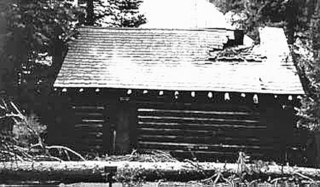
The Death Canyon Barn is a combination barn and ranger patrol cabin in Grand Teton National Park. The barn was built in Death Canyon on the Death Canyon Trail at its junction with the Alaska Basin Trail by the Civilian Conservation Corps in 1935 in the National Park Service rustic style. Located with a clear view of Prospector Mountain, it shares a common style and purpose with the Cascade Canyon Barn to the north in the park, with minor differences attributable to available materials and the preferences of the work crews building the barns.

The Triangle X Barn is a log barn at the Triangle X dude ranch in Grand Teton National Park. The barn was built by J.C. Turner, who used logs from neighbor John Fee's partly completed log cabin to begin construction of his barn in 1928. The barn, which is still in use, displays several methods of notching logs. It is notable as an illustration of the extent of the re-use of building materials that was common practice on what was in the early 20th century still almost a frontier settlement.

Edgemoor Farm Dairy Farm was built as part of a dairy farm in 1913 in Santee, California. Edgemoor was part of a Spanish land grant to Maria Antonio Estudillo who married Miguel de Pedrorena, a native of Madrid. By the 1850s, through a variety of ways, individuals obtained portions of the grant and began to farm. Walter Hamlin Dupee purchased Edgemoor Farm in 1913 and built it into a national award-winning dairy farm, polo pony ranch and early tourist attraction.
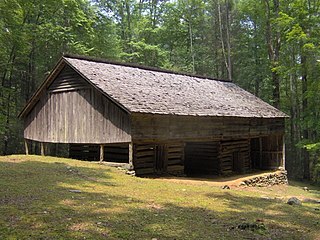
The John Messer Barn is a historic structure within the Great Smoky Mountains National Park in Sevier County, Tennessee, United States. Located along the Porters Creek Trail in the Greenbrier valley, it was constructed in 1875 by Pinkney Whaley. The Whaleys later sold their farm to John H. Messer, who was married to Pinkney's cousin, Lucy. In the 1930s, the Smoky Mountain Hiking Club, which constructed the Smoky Mountain Hiking Club Cabin nearby, leased the barn from the National Park Service. The barn was added to the National Register of Historic Places in 1976, and is the last surviving structure from the pre-park Greenbrier Cove community. This barn should not be confused with the Messer Barn in Cataloochee, which was built by John's cousin, Will Messer.
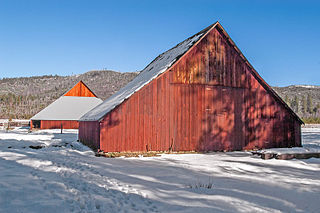
The McCauley and Meyer Barns in Yosemite National Park are the last barns in the park that retain their original characteristics as structures built by homesteaders. The McCauley barn and the two Meyer barns represent different construction techniques and styles of design.
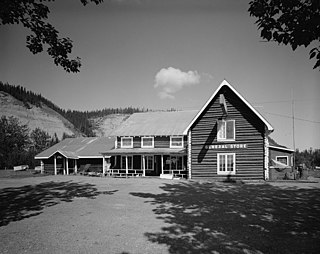
The Gakona Roadhouse is a historic traveler service facility in Gakona, Alaska, at mile 205 of the Glenn Highway. It is a 1-1/2 log structure with a gabled roof covered in corrugated metal. A shed-roof addition extends to the main block's east side. The roadhouse was built c. 1904, during the construction by the United States Army of the Trans-Alaska Military Road between Valdez and Eagle. This roadhouse was strategically located at a place where that road diverged from the old Eagle Trail, used by miners to reach the gold rush fields of the Yukon River. The original 1904 structure is used for storage; the present roadhouse facilities are provided by later (1920s) structures.
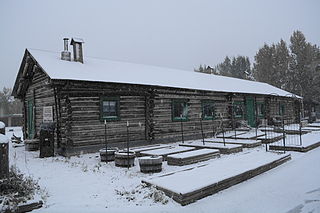
The Sullivan Roadhouse is a restored historic traveler's accommodation, operated as a museum in Delta Junction, Alaska, United States. The roadhouse was added to the National Register of Historic Places in 1979.
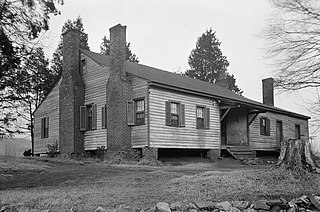
The Dudley Snow House is a historic residence in Oxford, Alabama. The house was built around 1832, soon after the Treaty of Cusseta and Muscogee removal in East Alabama. Brothers Dudley and Fielding Snow, born in North Carolina, came to Alabama from East Tennessee to found a farmstead. Dudley Snow built a one-and-a-half-story dogtrot house as the center of a complex that, by the mid-19th century, included a smokehouse, three barns, a cottonseed oil house, a cotton gin, grist mill, tannery, blacksmith shop, and slave quarters. Snow was a small-scale slaveholder, placing him in a class between a large planter and small farmer or sharecropper. The house was renovated in the 1960s, and was moved in the 1990s from the original address at 704 Snow Street to the actual location of Peek Drive, just across the Talladega County line, to make way for the expansion of Quintard Mall.

George W. Logan House, also known as Jobe Hill, is a historic home located near Rutherfordton, Rutherford County, North Carolina. It built about 1842, and is a one-story, five bay, Georgian plan frame dwelling. It is sheathed in weatherboard, has a side gable roof, and two rebuilt exterior end chimneys. It was enlarged and remodeled in the 1890s and in 1985. Also on the property are the contributing brick well house, dairy, outhouse, smokehouse, granary, log double corncrib, and a large log barn. It was the home of prominent North Carolina politician George Washington Logan (1815-1889).
Lewis Highsmith Farm, also known as Sweet Liberty, is a historic home and farm complex located near Harrells, Sampson County, North Carolina. The house was built about 1840, and is a large two-story, double pile, Federal style frame dwelling with a gable roof. The front facade features a full-width, two-tier front porch. The interior follows a hall-and-parlor plan. Also on the property are the contributing log smokehouse, the former kitchen, the gable roofed barn, and a nearby cluster of four tobacco barns.

The William Dillard Homestead is a historic homestead property in rural northeastern Stone County, Arkansas. It is located on the Round Bottom area northeast of Mountain View, on a plateau above the river's flood plain. It consists of two log structures, both now used as barns, that were built c. 1837, and are the oldest standing structures in the county. A single-pen log cabin stands on rough stone piers, and is covered by a gable roof. The walls are rough-hewn logs, joined by V notches. A shed-roof ell extends on the southern side of the structure, and more modern box-constructed sheds are attached to the north and east sides. A double crib barn stands across the road from the cabin.

The David Hanaford Farmstead is a historic farm in Monticello Township, Minnesota, United States. It was first settled in 1855 and features a farmhouse built in 1870 and a barn from around the same time. The farmstead was listed on the National Register of Historic Places in 1979 for having local significance in the themes of agriculture and exploration/settlement. It was nominated for being "an excellent example of an early Wright County farmstead developed by a pioneer family from New England."

The Nathaniel Butterworth House is a historic residence located north of Andrew, Iowa, United States. It is one of over 217 limestone structures in Jackson County from the mid-19th century, of which 101 are houses. The Butterworth house features a five bay symmetrical facade capped by a gable roof. The stones, which were said to have been quarried on this farm, are of various sizes and shapes and are laid in courses. Unlike many of the stone houses in Jackson County, the Butterworth house makes use of Classical entablature and pilasters around the transom and the sidelights of the main entry. The double end chimneys are found on only two other stone houses in the county.

The Los Burros Ranger Station is a forest ranger station situated in Apache County, Arizona. The station was staffed by rangers who traveled to the nearby Lake Mountain Lookout.
The Ramon Jaramillo House and Barn, on Encenada Rd. in Encenada, New Mexico, was listed on the National Register of Historic Places in 1986.
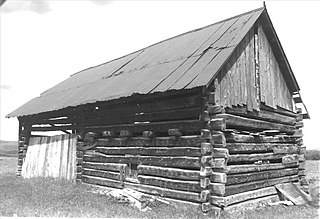
The Gilbert Martinez Barn near Los Ojos, New Mexico was built around 1875. It was listed on the National Register of Historic Places in 1985.

The Benjamin and Maria (Ogden) Drake Farm, also known as the Drake Farmstead, is a farmstead located at 927 North Drake Road in Kalamazoo, Michigan. It was listed on the National Register of Historic Places in 2012, and as of 2021 is open to the public as the Drake Farmstead Park.

















